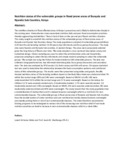| dc.contributor.author | Odida, Lynett Ochuma | |
| dc.contributor.author | Wakhungu, Jacob W. | |
| dc.date.accessioned | 2021-12-15T04:44:13Z | |
| dc.date.available | 2021-12-15T04:44:13Z | |
| dc.date.issued | 2020-09 | |
| dc.identifier.uri | https://www.ijsrit.com/uploaded_all_files/2510268161_q1.pdf | |
| dc.identifier.uri | http://ir-library.mmust.ac.ke:8080/xmlui/handle/123456789/1837 | |
| dc.description.abstract | The nutrition situation in flood affected areas in Kenya is precarious and is likely to deteriorate
sharply in the coming years. Humanitarian crises exacerbate nutrition risks and poor food
consumption practices thereby aggravating malnutrition. There is lack of data on the pre and post
floods nutrition situation. This study sought to establish the nutrition status of the vulnerable groups
in flood prone areas of Bunyala and Nyando Sub Counties, Kenya The study population consisted
of vulnerable groups (children 6-59 months and lactating mothers 15-49 years), key informants and
focus group discussions. The study sites were Nyando and Bunyala Sub counties, in western
Kenya. The areas were purposively selected given the long history of floods over time. The study
adopted a cross sectional descriptive survey and evaluation design. Cluster sampling was used to
select the administrative units and households, purposive sampling to select the key informants and
simple random sampling to select the vulnerable groups. The sample size using the Fishers
formulae totaled to 630 vulnerable persons. The data was collected using questionnaires, key
informant interview guide, focus group discussions and secondary data. The data was analyzed by
SPSS version 16, Nutri-survey and ENA soft wares. Chi square statistical test was used to
determine the relationship between the food consumption patterns and nutritional status of the
vulnerable groups. The results were then presented using tables and graphs. Results showed
nutrition status of the lactating mothers based on the Body Mass Index was undernourished 7%
within the normal range 39% and 56% were overweight. Based on MUAC cut offs 16% were
undernourished 56 % within the normal range and 21 % were overweight. Based on the indices for
children 1.5 % were severely stunted and o.6 moderately stunted, 1.3 % were severely wasted, 3.6
moderately wasted and 3.4% overweight. Based on MUAC, 4% were severely undernourished, 6%
were moderately undernourished and 40% were overweight. The study reveals that the study
population had a double burden of malnutrition and it’s skewed towards overweight which is a risk
factor for non-communicable diseases. The vulnerable groups in flood prone area of Bunyala and
Nyando Sub Counties have the double burden of under nutrition and over nutrition but mainly
skewed towards overweight and obesity putting them at risk of non-communicable diseases. The
study therefore recommends Existing programs to be redesigned to reduce risk of the increasing
over nutrition which if not made nutrition sensitive can lead to increase in non-communicable
diseases which is a silent killer. | en_US |
| dc.language.iso | en | en_US |
| dc.publisher | International Journal of Scientific Research and Innovative Technology | en_US |
| dc.subject | Nutrition, status , vulnerable, groups , flood, prone, areas | en_US |
| dc.title | Nutrition Status of the Vulnerable groups in flood prone areas of Bunyala and Nyando Sub Counties, Kenya. | en_US |
| dc.type | Article | en_US |

